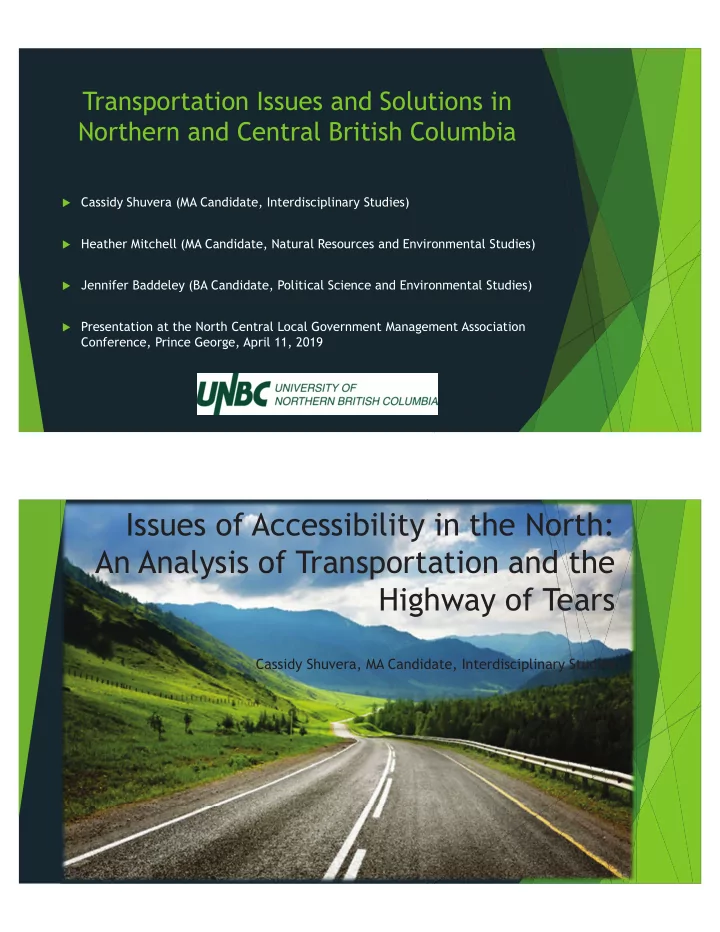

Transportation Issues and Solutions in Northern and Central British Columbia � Cassidy Shuvera (MA Candidate, Interdisciplinary Studies) � Heather Mitchell (MA Candidate, Natural Resources and Environmental Studies) � Jennifer Baddeley (BA Candidate, Political Science and Environmental Studies) � Presentation at the North Central Local Government Management Association Conference, Prince George, April 11, 2019 Issues of Accessibility in the North: An Analysis of Transportation and the Highway of Tears Cassidy Shuvera, MA Candidate, Interdisciplinary Studies
Background � Highway of Tears Symposium � Recommendation 1 - “That a shuttle bus transportation system be established between each town and city located along the entire length of Highway 16, defined as the Highway of Tears” � Transportation Action Plan � 5 point plan � Point 1- Transit Expansion “funding on a cost-shared basis with local communities to extend or enhance BC Transit services to better connect communities” Research Questions What is the current state of transportation in the north? Why did the plan take almost a decade to develop? Who was involved in the development of the plan? Did northern communities have input into the planning process?
Research Analysis: 2006 March- Highway of Tears Symposium � 2015 December – Transportation Action Plan (TAP) WHO HOW WHAT - Families - Media- 2005-2015 - Highway 16 Transportation - Local Government - Symposium Action Plan 2015 - Provincial - Greyhound Government - Inquiry - Non-governmental - UBCM WHY organizations - Question Period - Communities - Worldwide pressure- 2013-2014 - Limited transportation options in - Media - Public Consultation- 2014- present ublic Consultation 2 the north - Safety for women in the north The Bicycle, a Climate Change Solution for Small Northern Communities: Cyclists satisfaction of winter cycling plans and policy Supervisor: Darwin Horning Co Supervisor: Mark Groulx Supervisory Committee : Taylor Bachrach , Kyrke Gaudreau & Gary Wilson Heather Mitchell UNBC, MANRES CANDIDATE hmitchell@unbc. 1 ca
Zero emission physical and mental health benefits Economic benefits social equality benefits local air quality benefits affordable infrastructure benefits CONTEXT [1] Yang, L. 2010 1 0 Research Questions 3 1 2 How have cyclists experienced What are the policies, plans What are the their built, social, and characteristics of associated with summer natural environments? small northern and winter cycling in small Canadian cities that northern Canadian cities? Are the cycle transportation have the highest policies, plans, programs and growth in commutes by infrastructure reflective of bicycle? the users’ preferred experiences? FRAMING 1 2
Table 5: 2016 Journey to work - commutes via bicycle data greater than 1% Census Subdivision 2016 Cycle % 2010 – 2016 Cycle Growth % Jasper 23% 126% Revelstoke 15% 276% Whistler 10% 167% Banff 10% 171% Golden 10% 238% Fernie 9% 129% Canmore 7% 148% Smithers 5% 101% Nelson 5% 151% Pemberton 4% 195% Ignace 4% No data Sicamous 4% No data Squamish 4% No data Invermere 4% No data Valemount 4% No data Terrace 3% 66% Whitehorse 3% 108% Yellowknife 2% -92% Waterloo 2% -162% Chetwynd 2% No data Prince Rupert 1% No data Prince George 1% -20% Charlottetown 1% [1] Stats Canada 2017 Census [2] Gov BC 1 FRAMING 4 WHITEHORSE PRINCE GEORGE THE SMART/SPRAWLING The SPRAWLING city [1] city 4.8/km ² 60.2 / km ² km² SMITHERS The SMART city 515 / km ² FRAMING [1] Winters, M. 2007 1 5
WHAT WE ASKED BUILT & NATURAL ENVIRONMENT FRAMING 1 6 WHAT WE ASKED SOCIAL ENVIRONMENT FRAMING 1 7
WHAT WE HEARD #1 #1 #2 Very Positive ANALYSIS 2 8 If you build it, will they come? The expansion of electric vehicles into northern British Columbia. Supervisor: Dr. Gary Wilson Jennifer Baddeley Baddeley@unbc.ca
� Research Questions : � What are the barriers to the expansion of electric vehicles into Northern British Columbia? � What are the solutions to these barriers and who should be responsible for implementing them? � Barriers : � Geography: temperature, distance, public perception, and range anxiety � Infrastructure limitations � Affordability & availability of EVs � Solutions: � Increase public engagement and myth busting � Expand the charging station network � Create region specific rebates � Create EV in-stock quotas for dealerships Who should be responsible? � Actors in northern B.C. : � Government: Federal, Provincial, Local � Private Sector � Non-Government Organizations
Thank you! Cassidy Shuvera, Heather Mitchell, Jennifer Baddeley & Dr. Gary Wilson
Recommend
More recommend